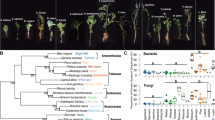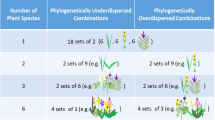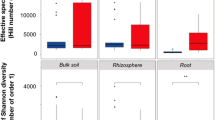Abstract
Investigations of plant-soil feedbacks (PSF) and plant-microbe interactions often rely exclusively on greenhouse experiments, yet we have little understanding of how, and when, results can be extrapolated to explain phenomena in nature. A systematic comparison of microbial communities using the same host species across study environments can inform the generalizability of such experiments. We used Illumina MiSeq sequencing to characterize the root-associated fungi of two foundation grasses from a greenhouse PSF experiment, a field PSF experiment, field monoculture stands, and naturally occurring resident plants in the field. A core community consisting < 10% of total fungal OTU richness but > 50% of total sequence abundance occurred in plants from all study types, demonstrating the ability of field and greenhouse experiments to capture the dominant component of natural communities. Fungal communities were plant species-specific across the study types, with the core community showing stronger host specificity than peripheral taxa. Roots from the greenhouse and field PSF experiments had lower among sample variability in community composition and higher diversity than those from naturally occurring, or planted monoculture plants from the field. Core and total fungal composition differed substantially across study types, and dissimilarity between fungal communities did not predict plant-soil feedbacks measured in experiments. These results suggest that rhizobiome assembly mechanisms in nature differ from the dynamics of short-term, inoculation studies. Our results validate the efficacy of common PSF experiment designs to test soil inoculum effects, and highlight the challenges of scaling the underlying microbial mechanisms of plant responses from whole-community inoculation experiments to natural ecosystems.





Similar content being viewed by others
References
Bever JD, Dickie IA, Facelli E, Facelli JM, Klironomos J, Moora M, Rillig MC, Stock WD, Tibbett M, Zobel M (2010) Rooting theories of plant community ecology in microbial interactions. Trends Ecol Evol 25:468–478. https://doi.org/10.1016/j.tree.2010.05.004
van der Putten WH, Bardgett RD, Bever JD, Bezemer TM, Casper BB, Fukami T, Kardol P, Klironomos JN, Kulmatiski A, Schweitzer JA, Suding KN, van de Voorde TFJ, Wardle DA (2013) Plant–soil feedbacks: the past, the present and future challenges. J Ecol 101:265–276. https://doi.org/10.1111/1365-2745.12054
Bever JD, Westover KM, Antonovics J (1997) Incorporating the soil community into plant population dynamics: the utility of the feedback approach. J Ecol 85:561–573. https://doi.org/10.2307/2960528
Klironomos JN (2002) Feedback with soil biota contributes to plant rarity and invasiveness in communities. Nature 417:67–70. https://doi.org/10.1038/417067a
Kardol P, Martijn Bezemer T, van der Putten WH (2006) Temporal variation in plant–soil feedback controls succession. Ecol Lett 9:1080–1088. https://doi.org/10.1111/j.1461-0248.2006.00953.x
Mangan SA, Schnitzer SA, Herre EA, Mack KML, Valencia MC, Sanchez EI, Bever JD (2010) Negative plant-soil feedback predicts tree-species relative abundance in a tropical forest. Nature 466:752–755. https://doi.org/10.1038/nature09273
Schnitzer SA, Klironomos JN, HilleRisLambers J, Kinkel LL, Reich PB, Xiao K, Rillig MC, Sikes BA, Callaway RM, Mangan SA, van Nes EH, Scheffer M (2011) Soil microbes drive the classic plant diversity–productivity pattern. Ecology 92:296–303. https://doi.org/10.1890/10-0773.1
Chung YA, Rudgers JA (2016) Plant–soil feedbacks promote negative frequency dependence in the coexistence of two aridland grasses. Proc R Soc B 283:20160608. https://doi.org/10.1098/rspb.2016.0608
Kulmatiski A, Beard KH, Stevens JR, Cobbold SM (2008) Plant–soil feedbacks: a meta-analytical review. Ecol Lett 11:980–992. https://doi.org/10.1111/j.1461-0248.2008.01209.x
Harrison KA, Bardgett RD (2010) Influence of plant species and soil conditions on plant–soil feedback in mixed grassland communities. J Ecol 98:384–395. https://doi.org/10.1111/j.1365-2745.2009.01614.x
Burns JH, Brandt AJ (2014) Heterogeneity in plant–soil feedbacks and resident population dynamics affect mutual invasibility. J Ecol 102:1048–1057. https://doi.org/10.1111/1365-2745.12258
Casper BB, Castelli JP (2007) Evaluating plant–soil feedback together with competition in a serpentine grassland. Ecol Lett 10:394–400. https://doi.org/10.1111/j.1461-0248.2007.01030.x
Casper BB, Bentivenga SP, Ji B, Doherty JH, Edenborn HM, Gustafson DJ (2008) Plant–soil feedback: testing the generality with the same grasses in serpentine and prairie soils. Ecology 89:2154–2164. https://doi.org/10.1890/07-1277.1
Pizano C, Mangan SA, Graham JH, Kitajima K (2014) Habitat-specific positive and negative effects of soil biota on seedling growth in a fragmented tropical montane landscape. Oikos 123:846–856. https://doi.org/10.1111/oik.01032
Heinze J, Sitte M, Schindhelm A, Wright J, Joshi J (2016) Plant-soil feedbacks: a comparative study on the relative importance of soil feedbacks in the greenhouse versus the field. Oecologia 181:559–569. https://doi.org/10.1007/s00442-016-3591-8
Hawkes CV, Kivlin SN, Rocca JD et al (2011) Fungal community responses to precipitation. Glob Chang Biol 17:1637–1645. https://doi.org/10.1111/j.1365-2486.2010.02327.x
Sýkorová Z, Ineichen K, Wiemken A, Redecker D (2007) The cultivation bias: different communities of arbuscular mycorrhizal fungi detected in roots from the field, from bait plants transplanted to the field, and from a greenhouse trap experiment. Mycorrhiza 18:1–14. https://doi.org/10.1007/s00572-007-0147-0
Phillips WS (2012) Drivers of arbuscular mycorrhizal fungal community composition in roots: hosts, neighbors, and environment. Oregon State University. https://ir.library.oregonstate.edu/concern/graduate_thesis_or_dissertations/c821gn69j. Accessed 13 March 2017
Schechter SP, Bruns TD (2013) A common garden test of host-symbiont specificity supports a dominant role for soil type in determining AMF assemblage structure in Collinsia sparsiflora. PLoS One 8:e55507. https://doi.org/10.1371/journal.pone.0055507
van der Putten WH, Kowalchuk GA, Brinkman EP, Doodeman GTA, van der Kaaij RM, Kamp AFD, Menting FBJ, Veenendaal EM (2007) Soil feedback of exotic savanna grass relates to pathogen absence and mycorrhizal selectivity. Ecology 88:978–988. https://doi.org/10.1890/06-1051
Pernilla Brinkman E, Van der Putten WH, Bakker E-J, Verhoeven KJF (2010) Plant–soil feedback: experimental approaches, statistical analyses and ecological interpretations. J Ecol 98:1063–1073. https://doi.org/10.1111/j.1365-2745.2010.01695.x
Lankau EW, Lankau RA (2014) Plant species capacity to drive soil fungal communities contributes to differential impacts of plant–soil legacies. Ecology 95:3221–3228. https://doi.org/10.1890/13-2342.1
Wagner MR, Lundberg DS, del Rio TG, Tringe SG, Dangl JL, Mitchell-Olds T (2016) Host genotype and age shape the leaf and root microbiomes of a wild perennial plant. Nat Commun 7:12151. https://doi.org/10.1038/ncomms12151
Saunders M, Kohn LM (2009) Evidence for alteration of fungal endophyte community assembly by host defense compounds. New Phytol 182:229–238. https://doi.org/10.1111/j.1469-8137.2008.02746.x
Newton AC, Fitt BDL, Atkins SD, Walters DR, Daniell TJ (2010) Pathogenesis, parasitism and mutualism in the trophic space of microbe–plant interactions. Trends Microbiol 18:365–373. https://doi.org/10.1016/j.tim.2010.06.002
Ravi S, D’Odorico P, Wang L, Collins S (2008) Form and function of grass ring patterns in arid grasslands: the role of abiotic controls. Oecologia 158:545–555. https://doi.org/10.1007/s00442-008-1164-1
Peters DPC, Yao J (2012) Long-term experimental loss of foundation species: consequences for dynamics at ecotones across heterogeneous landscapes. Ecosphere 3:1–23. https://doi.org/10.1890/ES11-00273.1
Collins SL, Xia Y (2015) Long-term dynamics and hotspots of change in a desert grassland plant community. Am Nat 185:E30–E43. https://doi.org/10.1086/679315
Ihrmark K, Bödeker ITM, Cruz-Martinez K, Friberg H, Kubartova A, Schenck J, Strid Y, Stenlid J, Brandström-Durling M, Clemmensen KE, Lindahl BD (2012) New primers to amplify the fungal ITS2 region – evaluation by 454-sequencing of artificial and natural communities. FEMS Microbiol Ecol 82:666–677. https://doi.org/10.1111/j.1574-6941.2012.01437.x
White TJ, Bruns TD, Lee S, Taylor JW (1990) Amplification and direct sequencing of fungal ribosomal RNA genes for phylogenetics. In: Innis MA, Gelfand DH, Sninsky JJ, White TJ (eds) PCR protocols: a guide to methods and applications. Academic Press, Inc., New York, pp 315–322
Lindahl BD, Nilsson RH, Tedersoo L, Abarenkov K, Carlsen T, Kjøller R, Kõljalg U, Pennanen T, Rosendahl S, Stenlid J, Kauserud H (2013) Fungal community analysis by high-throughput sequencing of amplified markers – a user’s guide. New Phytol 199:288–299. https://doi.org/10.1111/nph.12243
Porras-Alfaro A, Herrera J, Sinsabaugh RL, Odenbach KJ, Lowrey T, Natvig DO (2008) Novel root fungal consortium associated with a Dominant Desert grass. Appl Environ Microbiol 74:2805–2813. https://doi.org/10.1128/AEM.02769-07
Berry D, Mahfoudh KB, Wagner M, Loy A (2011) Barcoded primers used in multiplex amplicon pyrosequencing bias amplification. Appl Environ Microbiol 77:7846–7849. https://doi.org/10.1128/AEM.05220-11
Schloss PD, Westcott SL, Ryabin T, Hall JR, Hartmann M, Hollister EB, Lesniewski RA, Oakley BB, Parks DH, Robinson CJ, Sahl JW, Stres B, Thallinger GG, van Horn DJ, Weber CF (2009) Introducing mothur: open-source, platform-independent, community-supported software for describing and comparing microbial communities. Appl Environ Microbiol 75:7537–7541. https://doi.org/10.1128/AEM.01541-09
Huse SM, Welch DM, Morrison HG, Sogin ML (2010) Ironing out the wrinkles in the rare biosphere through improved OTU clustering. Environ Microbiol 12:1889–1898. https://doi.org/10.1111/j.1462-2920.2010.02193.x
Edgar RC, Haas BJ, Clemente JC, Quince C, Knight R (2011) UCHIME improves sensitivity and speed of chimera detection. Bioinformatics 27:2194–2200. https://doi.org/10.1093/bioinformatics/btr381
Nguyen NH, Smith D, Peay K, Kennedy P (2015) Parsing ecological signal from noise in next generation amplicon sequencing. New Phytol 205:1389–1393. https://doi.org/10.1111/nph.12923
Kõljalg U, Nilsson RH, Abarenkov K, Tedersoo L, Taylor AFS, Bahram M, Bates ST, Bruns TD, Bengtsson-Palme J, Callaghan TM, Douglas B, Drenkhan T, Eberhardt U, Dueñas M, Grebenc T, Griffith GW, Hartmann M, Kirk PM, Kohout P, Larsson E, Lindahl BD, Lücking R, Martín MP, Matheny PB, Nguyen NH, Niskanen T, Oja J, Peay KG, Peintner U, Peterson M, Põldmaa K, Saag L, Saar I, Schüßler A, Scott JA, Senés C, Smith ME, Suija A, Taylor DL, Telleria MT, Weiß M, Larsson K-H. 2013. Towards a unified paradigm for sequence-based identification of Fungi. Mol Ecol. https://doi.org/10.1111/mec.12481
McMurdie PJ, Holmes S (2014) Waste not, want not: why rarefying microbiome data is inadmissible. PLoS Comput Biol 10:e1003531. https://doi.org/10.1371/journal.pcbi.1003531
Clarke KR, Gorley RN (2009) Primer version 6.1.10 user manual and tutorial. Primer-E, Auckland
R Core Team (2018) R: a language and environment for statistical computing. R Foundation for Statistical Computing, Vienna
Fitzpatrick CR, Copeland J, Wang PW et al (2018) Assembly and ecological function of the root microbiome across angiosperm plant species. Proc Natl Acad Sci:201717617. https://doi.org/10.1073/pnas.1717617115
Aime MC, Phillips-Mora W (2005) The causal agents of witches’ broom and frosty pod rot of cacao (chocolate, Theobroma cacao) form a new lineage of Marasmiaceae. Mycologia 97:1012–1022
Wijayawardene NN, Camporesi E, Bhat DJ et al (2014) Macrodiplodiopsis in Lophiostomataceae. Pleosporales Phytotaxa 176:192–200
Baayen RP, van den PHJF B, Bonants PJM et al (2000) Fusarium Redolens f.sp asparagi, causal agent of Asparagus root rot, crown rot and spear rot. Eur J Plant Pathol 106:907–912. https://doi.org/10.1023/A:1008766707266
Maciá-Vicente JG, Jansson H-B, Abdullah SK et al (2008) Fungal root endophytes from natural vegetation in Mediterranean environments with special reference to fusarium spp. FEMS Microbiol Ecol 64:90–105. https://doi.org/10.1111/j.1574-6941.2007.00443.x
Bruton BD, Garcia-Jimenez J, Armengol J, Popham TW (2000) Assessment of virulence of Acremonium cucurbitacearum and Monosporascus cannonballus on Cucumis melo. Plant Dis 84:907–913. https://doi.org/10.1094/PDIS.2000.84.8.907
Porras-Alfaro A, Raghavan S, Garcia M, Sinsabaugh RL, Natvig DO, Lowrey TK (2014) Endophytic fungal symbionts associated with gypsophilous plants. Botany 92:295–301. https://doi.org/10.1139/cjb-2013-0178
Husband R, Herre EA, Turner SL, Gallery R, Young JPW (2002) Molecular diversity of arbuscular mycorrhizal fungi and patterns of host association over time and space in a tropical forest. Mol Ecol 11:2669–2678. https://doi.org/10.1046/j.1365-294X.2002.01647.x
Schweitzer JA, Bailey JK, Fischer DG, LeRoy CJ, Lonsdorf EV, Whitham TG, Hart SC (2008) Plant–soil–microorganism interactions: heritable relationship between plant genotype and associated soil microorganisms. Ecology 89:773–781. https://doi.org/10.1890/07-0337.1
Fujimura KE, Egger KN (2012) Host plant and environment influence community assembly of high Arctic root-associated fungal communities. Fungal Ecol 5:409–418. https://doi.org/10.1016/j.funeco.2011.12.010
Burke IC, Lauenroth WK, Vinton MA, Hook PB, Kelly RH, Epstein HE, Aguiar MR, Robles MD, Aguilera MO, Murphy KL, Gill RA (1998) Plant-soil interactions in temperate grasslands. Plant-induced soil changes: processes and feedbacks. Springer, Dordrecht, pp 121–143
Husband R, Herre EA, Young JPW (2002) Temporal variation in the arbuscular mycorrhizal communities colonising seedlings in a tropical forest. FEMS Microbiol Ecol 42:131–136. https://doi.org/10.1111/j.1574-6941.2002.tb01002.x
Johnson NC, Rowland DL, Corkidi L, Egerton-Warburton LM, Allen EB (2003) Nitrogen enrichment alters mycorrhizal allocation at five Mesic to semiarid grasslands. Ecology 84:1895–1908. https://doi.org/10.1890/0012-9658(2003)084[1895:NEAMAA]2.0.CO;2
Berg G, Smalla K (2009) Plant species and soil type cooperatively shape the structure and function of microbial communities in the rhizosphere. FEMS Microbiol Ecol 68:1–13. https://doi.org/10.1111/j.1574-6941.2009.00654.x
Philippot L, Raaijmakers JM, Lemanceau P, van der Putten WH (2013) Going back to the roots: the microbial ecology of the rhizosphere. Nat Rev Microbiol 11:789–799. https://doi.org/10.1038/nrmicro3109
Grman E, Suding KN (2010) Within-year soil legacies contribute to strong priority effects of exotics on native California grassland communities. Restor Ecol 18:664–670. https://doi.org/10.1111/j.1526-100X.2008.00497.x
Glassman SI, Levine CR, DiRocco AM et al (2016) Ectomycorrhizal fungal spore bank recovery after a severe forest fire: some like it hot. ISME J 10:1228–1239. https://doi.org/10.1038/ismej.2015.182
Packer A, Clay K (2000) Soil pathogens and spatial patterns of seedling mortality in a temperate tree. Nature 404:278–281. https://doi.org/10.1038/35005072
Mack KML, Bever JD (2014) Coexistence and relative abundance in plant communities are determined by feedbacks when the scale of feedback and dispersal is local. J Ecol 102:1195–1201. https://doi.org/10.1111/1365-2745.12269
Kardol P, De Deyn GB, Laliberté E et al (2013) Biotic plant–soil feedbacks across temporal scales. J Ecol 101:309–315. https://doi.org/10.1111/1365-2745.12046
Develey-Rivière M-P, Galiana E (2007) Resistance to pathogens and host developmental stage: a multifaceted relationship within the plant kingdom. New Phytol 175:405–416. https://doi.org/10.1111/j.1469-8137.2007.02130.x
Porras-Alfaro A, Bayman P (2011) Hidden Fungi, emergent properties: endophytes and microbiomes. Annu Rev Phytopathol 49:291–315. https://doi.org/10.1146/annurev-phyto-080508-081831
Prober SM, Leff JW, Bates ST, Borer ET, Firn J, Harpole WS, Lind EM, Seabloom EW, Adler PB, Bakker JD, Cleland EE, DeCrappeo NM, DeLorenze E, Hagenah N, Hautier Y, Hofmockel KS, Kirkman KP, Knops JMH, la Pierre KJ, MacDougall AS, McCulley RL, Mitchell CE, Risch AC, Schuetz M, Stevens CJ, Williams RJ, Fierer N (2015) Plant diversity predicts beta but not alpha diversity of soil microbes across grasslands worldwide. Ecol Lett 18:85–95. https://doi.org/10.1111/ele.12381
Wubs ERJ, Putten WH, van der Bosch M, Bezemer TM (2016) Soil inoculation steers restoration of terrestrial ecosystems. Nat Plants 2:16107. https://doi.org/10.1038/nplants.2016.107
Acknowledgements
Our greatest thanks to Christopher Reazin for the assistance in the laboratory and with bioinformatics, and to Scott Collins for LTER directorship and for designing the field monocultures. We also thank Stephanie Kivlin, Robert Sinsbaugh, and the Natvig lab for comments on an early draft of this manuscript, the Sevilleta LTER field crew members for years of data collection, and the USFWS staff at the Sevilleta National Wildlife Refuge for support.
Funding
This work was funded by a NSF Doctoral Dissertation Improvement Grant to Chung (NSF-1601210), NSF DEB 1456955 to Rudgers, and the Sevilleta LTER awards (NSF-1748133, 1440478).
Author information
Authors and Affiliations
Corresponding author
Electronic Supplementary Material
ESM 1
(DOCX 2506 kb)
Rights and permissions
About this article
Cite this article
Chung, Y.A., Jumpponen, A. & Rudgers, J.A. Divergence in Diversity and Composition of Root-Associated Fungi Between Greenhouse and Field Studies in a Semiarid Grassland. Microb Ecol 78, 122–135 (2019). https://doi.org/10.1007/s00248-018-1277-y
Received:
Accepted:
Published:
Issue Date:
DOI: https://doi.org/10.1007/s00248-018-1277-y




